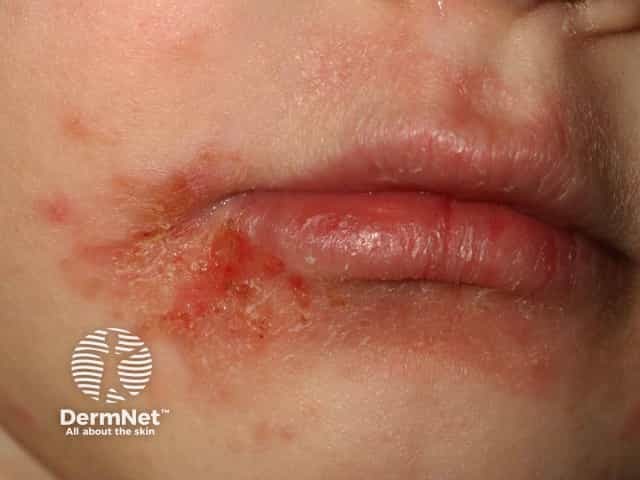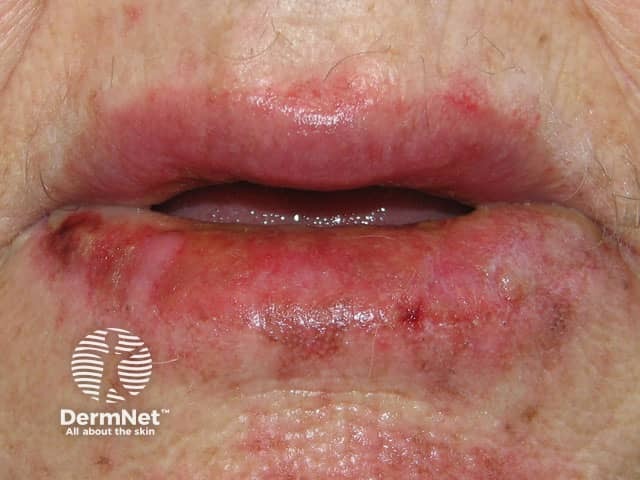Main menu
Common skin conditions

NEWS
Join DermNet PRO
Read more
Quick links
Eczematous cheilitis — extra information
Introduction
Demographics
Clinical features
Causes
Treatment
What is eczematous cheilitis?
Eczematous cheilitis is inflammation of the lips presenting as redness with dryness and scaling. It may also be called lip dermatitis. The lips may be divided into three zones – the outer zone comprising the skin next to the lips, the vermilion margin and the mucosal aspect. The first two areas are the most commonly affected. The major causes of eczematous cheilitis are atopic dermatitis and irritant or allergic contact reactions.

Atopic cheilitis

Atopic cheilitis

Irritant cheilitis
Who gets eczematous cheilitis and why?
Eczematous cheilitis can be divided into two major groups based on the cause:
- Endogenous, meaning it is due to an inherent characteristic of the person. Atopic dermatitis is the most common example of this form of eczematous cheilitis.
- Exogenous, meaning it is due to something from outside the body. This group can be further subdivided into:
- Irritant contact cheilitis – lip-licking is the major cause of this type of eczematous cheilitis. Other common causes of irritant cheilitis include cosmetics, foods and environmental factors.
- Allergic contact cheilitis – a relevant allergic reaction is identified in at least one-quarter of cases of eczematous cheilitis. Common sources of allergens include lipsticks and other lip care products, toothpaste and dental materials, foods, medications and nail varnish.
Often a combination of factors is present.
Rarely, contact urticaria can present as cheilitis when the allergen is used in small amount frequently, such as the flavouring in a toothpaste.
Sometimes no cause can be identified.
Clinical features of eczematous cheilitis
The chronic form of eczematous cheilitis presents with redness, dryness, scaling and fissuring. The angle of the mouth is often also involved (angular cheilitis).
The perioral skin and vermilion margin (where the red mucosa meets the skin) are the most commonly affected parts of the lips.
It is important to look for and note skin and mucosal lesions elsewhere as these may give a clue as to the cause.
How is the cause of eczematous cheilitis identified?
Careful history and examination may help to narrow down the list of possible causes. The examination should include the lips, inside the mouth, and the skin in general.
Patch testing is very useful in eczematous cheilitis as at least one-quarter of cases involve an allergic reaction. Testing should include the standard series as well as extended series such as for lipsticks, toothpaste and others as suggested from the history. Testing the patient’s own products ‘as is’ is important. Photopatch testing may also be useful. The relevance of positive reactions must be considered.
If patch testing is negative, prick testing may be positive, indicating the diagnosis may be contact urticaria.
What is the treatment of eczematous cheilitis?
Treatment will depend on the cause. Where an exogenous cause has been identified, this should be avoided if possible. If this does not result in improvement, consider another factor such as a second allergen, irritant or endogenous cause.
Moisturisers and topical corticosteroids may be recommended for atopic cheilitis.
References
- Freeman S, Stephens R. Cheilitis: analysis of 75 cases referred to a contact dermatitis clinic. Am J Contact Dermat. 1999 Dec;10(4):198–200. doi: 10.1053/AJCD01000198. PMID: 10594294.
- Lim SW, Goh CL. Epidemiology of eczematous cheilitis at a tertiary dermatological referral centre in Singapore. Contact Dermatitis. 2000 Dec;43(6):322–6. doi: 10.1034/j.1600-0536.2000.043006322.x. PMID: 11140381.
- Torgerson RR, Davis MD, Bruce AJ, Farmer SA, Rogers RS 3rd. Contact allergy in oral disease. J Am Acad Dermatol. 2007 Aug;57(2):315–21. doi: 10.1016/j.jaad.2007.04.017. Epub 2007 May 25. PMID: 17532095.
On DermNet
- Cheilitis
- Atopic dermatitis
- Irritant contact dermatitis
- Allergic contact dermatitis
- Allergic contact cheilitis
- Eczematous Cheilitis
- Pigmented contact cheilitis
- Cheilitis in musicians
- Contact reactions to lipsticks and other lipcare products
- Angular cheilitis
